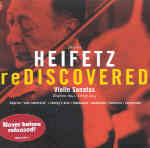Presumably owing to his status as King of the Hill among violinists, every scrap of Jascha Heifetz’s huge recorded output is now on CD and even recordings of live concerts and broadcasts are becoming ubiquitous. Now, RCA’s found a new lode to mine: unissued studio recordings. This entry in the label’s “Rediscovered” series includes major works such as the Grieg and Brahms Sonatas from 1936 that never were approved for release. RCA’s booklet notes aren’t overly forthcoming about why Heifetz didn’t okay these and the shorter pieces on the program. The producers have spliced in replacements for some wrong notes in the first movement of the Brahms, and in those pre-tape days Heifetz simply may not have wanted to do a full remake, leaving a re-recording for another day, which never came. RCA intended the Grieg as an update to its 1928 Kreisler/Rachmaninov version and these ears (most assuredly less acute than Heifetz’s) can discover nothing remotely objectionable enough to warrant scrapping. But Heifetz may simply have felt out of sorts that day or just wanted to stick it to the suits in the front office. Who knows? Celebrity virtuosos tend to be a capricious lot. In any event, this disc represents more than archeological digging in the vaults; it’s an important addition to the Heifetz discography and includes worthy but far from ideal performances whose resuscitation deserves gratitude.
The slashing bow strokes at the start of the Grieg are startling if you’re familiar with the gentler warmth of the Kreisler, but so is the rest of the piece, so intense when placed alongside Kreisler’s sweet singing rendition. Heifetz also plays up the stark contrasts he finds in the work, the tension of the opening bars dissipated by the rich velvet plush of his tone in the main theme, perceptibly slowing down for its introduction. Kreisler and Rachmaninov, with their kinder, gentler opening need only add a touch of rubato to move smoothly into the theme. Therein lies the major difference between the two interpretations: Heifetz is volcanic, playing each section for all it’s worth with the result that there’s almost more electricity than the sonata can bear; Kreisler’s is more of a piece, transitions don’t come with “Warning, Transition Ahead” signs at the roadside. Only seconds separate the timings of the two recordings, but they seem miles apart as Kreisler offers an Old-World, gemütlich humanity and Heifetz a machine-age sleekness.
That’s not a put-down, for the plush baritonal huskiness of Heifetz’s instrument in its mid-to-low range belies his reputation for coldness. Nor does he refuse to pepper the work with the portamentos and rubatos that became anathema to his wannabe followers. So this long-lost Heifetz is a terrific must-hear performance. But it does raise legitimate questions about whether all that fire doesn’t consume the piece rather than enhance it.
The Brahms is a more conventional reading, if any performance with so much wattage can be called “conventional”. From the opening bars we hear Heifetz’s inimitable phrasing and tonal luster “speaking” the music in the older style that became less evident in his post-war recordings. In the Adagio he spins an endless, seamless legato that’s breathtaking, and in the outer movements he plays with fiery accuracy. Again, timings between this and my favorite modern recording, the Suk/Katchen on Decca, aren’t all that significant (a little more than a minute in the first movement, mere seconds in the other two) but there’s more lyricism in the Suk and more intensity–perhaps too much intensity–in the Heifetz, which still has its poetic moments even if they’re tightly wound. Long-time accompanist Emanuel Bay does what all Heifetz’s accompanists do–he’s unobtrusive except for some plink-plonks when the spotlight shines on him and otherwise partners away in the background.
The shorter fillers include a stunningly played Leopold Auer arrangement of Lensky’s Aria from Eugen Onegin. In 1922, Heifetz, for all his amazing brilliance and technical facility, was still an Old-World violinist playing in the bel canto style, and this recording makes you want to hear a singer capable of matching the legato phrasing and soulfulness of Heifetz’s violin interpretation of the aria. From 1924 come fireworks such as Wieniawski’s Étude Op. 10 No. 5 and various encore specialties, including arrangements of Rameau’s Tambourine and Bach’s Sicilienne from his E-flat flute and harpsichord sonata. The novelty is a 1928 impromptu post-session four-hand piano improv on the song “Valencia”, played by Isidor Achron and the great man himself. RCA has refurbished the ancient sonics, preserving the unique Heifetz sound and making it as fresh and vital as if these recordings had been made decades later.
































